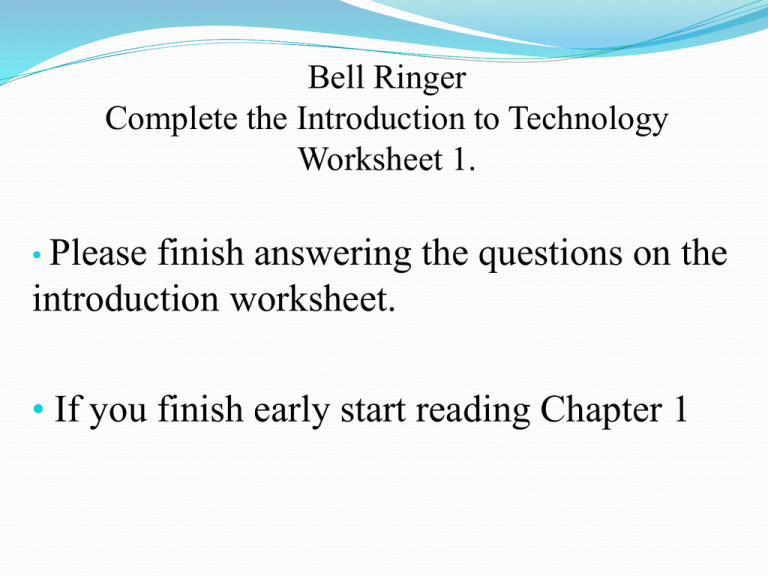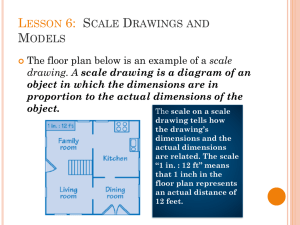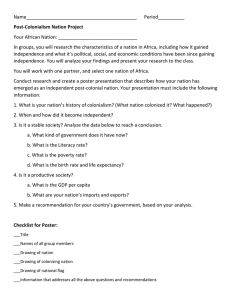The Design Process
advertisement

Bell Ringer Complete the Introduction to Technology Worksheet 1. • Please finish answering the questions on the introduction worksheet. • If you finish early start reading Chapter 1 Today you will: Revise what technology is and how it affects our lives. Learn about the Design Process. Begin designing your Tall Tee Tower. Definitions Technology – the knowledge and process used to solve problems by designing and making products or structures. Technologist – a person who solves problems by designing and making products or structures. Definitions Engineering - The application of scientific and mathematical principles to practical ends such as the design, manufacture, and operation of. Scientist – persons whose field of study that is concerned with the laws of nature. Problem Solving http://www.ted.com/talks/lang/eng/stuart_brown_says_play_is_more_than_fun_it_s_vital.html Design Process Identify the Problem Design Brief Investigation Research Developing alternative solutions Chosen Solution Create a detailed drawing Prototype Testing & Evaluations 1) Identify the Problem Clearly write down what the problem or need is. 2) Design Brief Also called a design challenge Introduces the problem Describes what the designer (you) will do Introduces what the solution will accomplish States specifications Should set limits Help direct the design effort 3) Investigation Learn more about the problem Make a list of questions which you believe need to be answered Research possible solutions 4) Research Research past inventions too see if they could be improved to solve your current problem. Research different materials that you could use to solve the problem. Wood Metal Ceramic Plastic 5) Developing Alternative Solutions Several technical sketches in color Each solutions should be workable but may vary: Aesthetics Cost Materials List the solutions strengths and weakness 6) Chosen Solution Dose it meet the criteria established in the design brief and specifications? Somehow proven “better” than other considered solutions Decision Matrix Asking a sample of people 7) Create Detailed Drawing All parts should be labeled Should have a title box Should include different types of lines: Object lines Hidden Lines Dimension Lines Extension Lines Usually made in industry on computer software 8) Modeling & Prototyping A model is a full-size or small-scale object, usually made from a different material then the final manufactured product. A Prototype is the first product made; it is made from the final materials and it is made to the final dimensions. You need to consider such things as: Aesthetics Ergonomics Materials Fastening or joining Finishing Safety 9) Testing & Evaluations Testing List the possible ways in which your chosen solution may be tested Test your product Record the results 9) Testing & Evaluations Evaluating Product evaluation What are the strengths and weaknesses of the final design? Did your final solution meet the design brief and the specifications? How could the design be improved? Group evaluation Did your group use its time effectively? What would you have done differentially ? The Design Process 1. Identify the problem or need. 2. Write a design brief. (What the product must do) 3. Investigation, you must consider function, appearance, materials, construction, Safety. 4. Research what is available and what has come before. 5. Develop and consider alternative solutions. (sketch ideas) 6. Choose a solution. (Why) 7. Make a detailed drawing of your chosen solution. 8. Make a model and prototype. 9. Test and evaluate. Tall Tee Tower Handout Technical Drawing Requirements A Border must be neatly drawn ½ inch inside of the page. Golf Ball 1. A straight lined border box. (10 points) 2. 2 boxes in the bottom right hand corner with you and your partners name, and the name of the drawing in them. (10 points) 3. A drawing of your tower. (10 points) 4. All of the parts are shown. (10 points) 5. All of the different parts have names to identify them. (10 points) 6. There are at least 3 dimensions showing the size of your tower. (10 points) Note: Using straight lines and a neat drawing is needed to receive the most points. Index Card Tape 24 inches Printer paper folded into triangular prisms 11 inches 5 inches Note: Your drawing must not touch the border Neatly print your name here inside of a box. Neatly print the name of your drawing here inside of a box.






